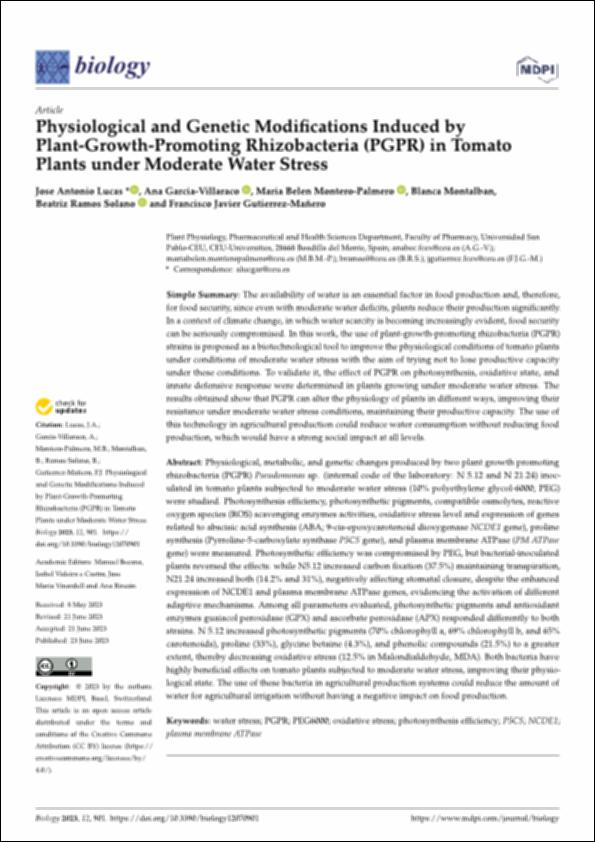Por favor, use este identificador para citar o enlazar este ítem:
http://hdl.handle.net/10637/14706Physiological and Genetic Modifications Induced by Plant-Growth-Promoting Rhizobacteria (PGPR) in Tomato Plants under Moderate Water Stress
| Título : | Physiological and Genetic Modifications Induced by Plant-Growth-Promoting Rhizobacteria (PGPR) in Tomato Plants under Moderate Water Stress |
| Autor : | Lucas García, José Antonio García Villaraco, Ana Montero Palmero, María Belén Montalbán Ginés, Blanca Ramos Solano, Beatriz Gutierrez-Mañero, Francisco Javier |
| Materias: | Water stress; PGPR; PEG6000; Oxidative stress; Photosynthesis efficiency; P5CS; NCDE1; Plasma membrane ATPase |
| Editorial : | MDPI |
| Citación : | Lucas, J.A.; Garcia-Villaraco, A.; Montero-Palmero, M.B.; Montalban, B.; Ramos Solano, B.; Gutierrez-Mañero, F.J. Physiological and Genetic Modifications Induced by Plant-Growth-Promoting Rhizobacteria (PGPR) in Tomato Plants under ModerateWater Stress. Biology 2023, 12, 901. https:// doi.org/10.3390/biology12070901 |
| Resumen : | Physiological, metabolic, and genetic changes produced by two plant growth promoting rhizobacteria (PGPR) Pseudomonas sp. (internal code of the laboratory: N 5.12 and N 21.24) inoculated in tomato plants subjected to moderate water stress (10% polyethylene glycol-6000; PEG) were studied. Photosynthesis efficiency, photosynthetic pigments, compatible osmolytes, reactive oxygen species (ROS) scavenging enzymes activities, oxidative stress level and expression of genes related to abscisic acid synthesis (ABA; 9-cis-epoxycarotenoid dioxygenase NCDE1 gene), proline synthesis (Pyrroline-5-carboxylate synthase P5CS gene), and plasma membrane ATPase (PM ATPase gene) were measured. Photosynthetic efficiency was compromised by PEG, but bacterial-inoculated plants reversed the effects: while N5.12 increased carbon fixation (37.5%) maintaining transpiration, N21.24 increased both (14.2% and 31%), negatively affecting stomatal closure, despite the enhanced expression of NCDE1 and plasma membrane ATPase genes, evidencing the activation of different adaptive mechanisms. Among all parameters evaluated, photosynthetic pigments and antioxidant enzymes guaiacol peroxidase (GPX) and ascorbate peroxidase (APX) responded differently to both strains. N 5.12 increased photosynthetic pigments (70% chlorophyll a, 69% chlorophyll b, and 65% carotenoids), proline (33%), glycine betaine (4.3%), and phenolic compounds (21.5%) to a greater extent, thereby decreasing oxidative stress (12.5% in Malondialdehyde, MDA). Both bacteria have highly beneficial effects on tomato plants subjected to moderate water stress, improving their physiological state. The use of these bacteria in agricultural production systems could reduce the amount of water for agricultural irrigation without having a negative impact on food production. |
| URI : | http://hdl.handle.net/10637/14706 |
| Derechos: | http://creativecommons.org/licenses/by-nc-nd/4.0/deed.es Open Access |
| ISSN : | 2079-7737 |
| Fecha de publicación : | 23-jun-2023 |
| Centro : | Universidad San Pablo-CEU |
| Aparece en las colecciones: | Facultad de Farmacia |
Los ítems de DSpace están protegidos por copyright, con todos los derechos reservados, a menos que se indique lo contrario.


